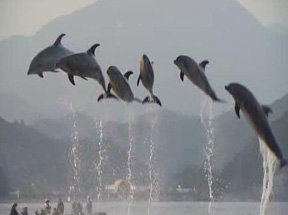|
|
Interview: The CoveDirector Louie Psihoyos and Producer Fisher StevensBy Tom MacyAugust 5, 2009
And on one of the trips we screened Crazy Love, this other film I was involved in, and about six months later Jim said, hey look, we'd really like you to help out on this epic journey that Louie had already been on for two years. I looked at some of the footage that Louie had done and I was blown away. I thought there was an amazing film here. My idea was to make it an action thriller, even though it's a doc, but make it like it's not a doc - almost like you don't know if you're seeing the real thing or a fictional film. So basically, I brought on Geoffrey Richman, who edited Sicko and Murderball, [and] Mark Monroe (he and I made a film called Once in a Lifetime) to come in and write and we came up with what you guys saw. Louie, when did you get started on this? Louie Psihoyos: I've been working for National Geographic over the course of about 18 years as a still photographer; I worked for Fortune Magazine for about five, that's where I met Jim. I was a pretty successful still photographer but I feel like I was just walking in the wilderness until now. This is such a more powerful experience. Making a film is just...I wish I would've done this 20-30 years ago. I've reached so many more people in a deeper way. I've never seen a businessman cry over anything I did for National Geographic. You see audiences reacting like that - laughing, crying, cheering, standing ovations and people asking what they can do to help. It's a really, really powerful experience. When Jim gave me the money to do this film, he said just make a difference. Coming from a guy who's used to hitting it out of the park all the time, I thought, I really need to try to change the world, because that's what he does.
|

|
|
|

|
Friday, November 1, 2024
© 2024 Box Office Prophets, a division of One Of Us, Inc.


